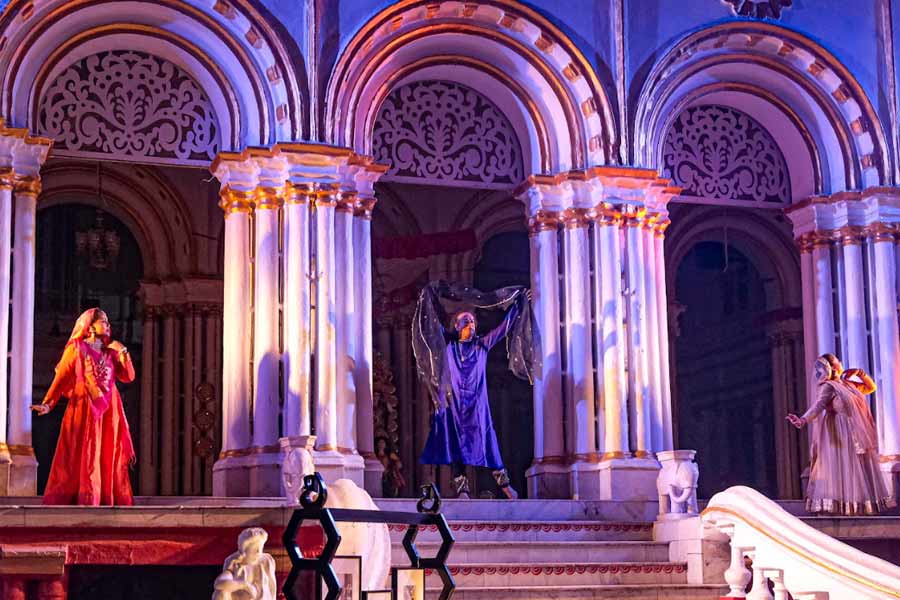The onset of winter in Kolkata is often accompanied by a remarkable rise in artistic and cultural events. Delhi Art Gallery (DAG) has been kick-starting the city’s cultural calendar for the past three years with their annual festival, The City as a Museum. This year, the cultural group raised the stakes with nine events for the fourth edition, held from November 16 to 24. My Kolkata takes you through what went down over a course of 10 days.
Adhi Nai, Tebhag Chai
The Directorate of State Archives at Shakespeare Sarani (formerly Theatre Road) in Kolkata’s central business district opened its doors to a unique installation on the Tebhaga Movement. Centred around the peasant resistance under the leadership of Bangiya Pradeshnik Kishan Sabha, this exhibition investigated the agrarian resistance in various districts of 1940s Bengal. It also comprised reports of state-sanctioned surveillance from colonial archives, coupled with visual and oral testimonials from those on the frontlines.
The exhibition was also the setting for an interactive session titled Tebhaga Women Speak, on the Tebhaga Women’s Movement with author Kavita Panjabi and actor Mahasweta Ray.
Mappa Theke Manchitra
The 140-year-old archives at PM Bagchi and Company’s Sovabazar office in north Kolkata provided a fascinating peek into Kolkata’s evolution over the 18th and 19th centuries through its maps. Academics Epsita Halder and Sarbajit Mitra juxtaposed colonial and indigenous mapping techniques to elucidate the contrast between the White and Black town, while also taking the audience on a heritage walk around the neighbourhood’s most iconic spots.
The Revolutionary Art of Chittaprosad and Somnath Hore
The Tebhaga exhibition at Shakespeare Sarani hosted a second event. Academic Sanjoy Kumar Mallik from Kala Bhavana of Visva-Bharati University in Santiniketan held a talk on Somnath Hore and Chittaprosad Bhattacharya’s visual representation of the Bengal Famine in 1943-44, and the Tebhag Movement. The session made the exhibition come alive, adding context to the artworks, photographs and oral narratives.
The White ‘Other’

Gypsy-jazz band, The Big Other, made people dance atop the Bengal Paddle, incorporating trivia about Europeans othered by the colonial masters Amit Pramanik
People boarded the The Bengal Paddle and enjoyed unmatched views of the riverfront, as archivist Sarmishta De shared the story of Europeans who were othered by the colonial rulers and had to live on Kolkata’s fringes, in sharp contrast to the elite English. The session was followed by a foot-tapping concert by gypsy-jazz band, The Big Other.
Settling in the City
Partition has always been an immensely sensitive topic for Bengal, and this session at Tetultalar Chhad, Vidyasagar Colony near Jadavpur in south Kolkata, brought together scholars Anwesha Sengupta and Samata Biswas with filmmaker and photographer Debalina Majumder to examine this topic in depth. The trio traced the rehabilitation efforts of refugees from East Pakistan to Kolkata in 1947 through an array of images, texts and memoirs that analysed ideas of home and settlement.
E Ek Ashcharja! Kalikata Kalankini; Athaba Chaaper Naksha Prahasan

This production about the representation of working class women in 19th century Bengal lit up Sovabazar Natmandir
Birati Samuho Performers Collective set up this production based on the Battala texts at the grand Sovabazar Natmandir. This performance spread over two days explored the representation of working class women in the public sphere and print culture during the 19th century.
Reform Screams

Sampurna Chakraborty expanded upon the waves of artistic dissent enabled within and beyond the walls of Government College of Art and Craft
The Government College of Art and Craft has provided Bengal a space for intellectual discourse and artistry since 1854. This made it the perfect setting for this event, which mapped a brief history of reforms and dissent in art emerging both within and beyond the city’s beloved art school.
Art historian and archivist Sampurna Chakraborty was at the helm of the session, which explored independent initiatives by institutes, collectives and publications at the turn of the 20th century, shedding light on one of golden periods of creative expression in the state.
Mehfil-E-Thumri

Kathak and Thumri’s unique relationship made for a memorable concert at this event, which concluded the festival Sannidh Raychaudhuri
The epic closure of the festival took place at Khelat Ghosh’s regal Pathuriaghata residence, where academic Shantanu Majee explored the evolution of Thumri as a form of classical music, interspersed with stories of baijis and tawaifs. This was followed by a soul-stirring concert, where Sanjana Roy Chakraborty’s vocals and Parimal Chakrabarty’s prowess with the tabla were heightened by Ashimbandhu Bhattacharya and his team’s ability to tell stories of Indian mythology with Kathak.
“The City as a Museum grows in scope and scale each year and we are proud to see the ways in which it has contributed to a greater appreciation for the city, its diverse histories, and our shared heritage of art and culture. We hope that it not only highlights histories that are often forgotten or at the periphery but also encourages all of us to navigate the city everyday with a greater sense of wonder, curiosity and openness,” said Sumona Chakravarty, vice-president of museums at DAG.



